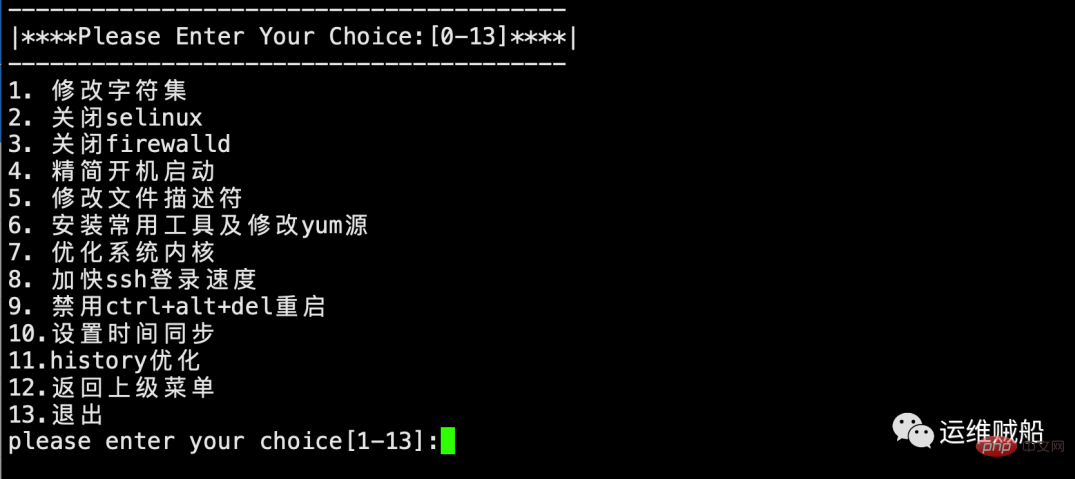

Recently, I found a relatively easy-to-use shell source code based on the recommendation of fans. I adapted it based on this and shared it with everyone.
Main menu:

Secondary menu:

# Mainly realizes various optimizations of the system, such as commonly used functions such as modifying character sets, turning off selinux, turning off firewalls, installing commonly used tools, and accelerating SSH login. .
牛逼啊!接私活必备的 N 个开源项目!赶快收藏吧
#!/bin/sh
. /etc/rc.d/init.d/functions
export LANG=zh_CN.UTF-8
#一级菜单
menu1()
{
clear
cat <<eof
----------------------------------------
|**** 欢迎使用cetnos7.9优化脚本 ****|
|**** 博客地址: aaa.al ****|
----------------------------------------
1. 一键优化
2. 自定义优化
3. 退出
EOF
read -p "please enter your choice[1-3]:" num1
}
#二级菜单
menu2()
{
clear
cat <<eof
----------------------------------------
|****Please Enter Your Choice:[0-13]****|
----------------------------------------
1. 修改字符集
2. 关闭selinux
3. 关闭firewalld
4. 精简开机启动
5. 修改文件描述符
6. 安装常用工具及修改yum源
7. 优化系统内核
8. 加快ssh登录速度
9. 禁用ctrl+alt+del重启
10.设置时间同步
11.history优化
12.返回上级菜单
13.退出
EOF
read -p "please enter your choice[1-13]:" num2
}
#1.修改字符集
localeset()
{
echo "========================修改字符集========================="
cat > /etc/locale.conf <<eof
LANG="zh_CN.UTF-8"
#LANG="en_US.UTF-8"
SYSFONT="latarcyrheb-sun16"
EOF
source /etc/locale.conf
echo "#cat /etc/locale.conf"
cat /etc/locale.conf
action "完成修改字符集" /bin/true
echo "==========================================================="
sleep 2
}
#2.关闭selinux
selinuxset()
{
selinux_status=`grep "SELINUX=disabled" /etc/sysconfig/selinux | wc -l`
echo "========================禁用SELINUX========================"
if [ $selinux_status -eq 0 ];then
sed -i "s#SELINUX=enforcing#SELINUX=disabled#g" /etc/sysconfig/selinux
setenforce 0
echo '#grep SELINUX=disabled /etc/sysconfig/selinux'
grep SELINUX=disabled /etc/sysconfig/selinux
echo '#getenforce'
getenforce
else
echo 'SELINUX已处于关闭状态'
echo '#grep SELINUX=disabled /etc/sysconfig/selinux'
grep SELINUX=disabled /etc/sysconfig/selinux
echo '#getenforce'
getenforce
fi
action "完成禁用SELINUX" /bin/true
echo "==========================================================="
sleep 2
}
#3.关闭firewalld
firewalldset()
{
echo "=======================禁用firewalld========================"
systemctl stop firewalld.service &> /dev/null
echo '#firewall-cmd --state'
firewall-cmd --state
systemctl disable firewalld.service &> /dev/null
echo '#systemctl list-unit-files | grep firewalld'
systemctl list-unit-files | grep firewalld
action "完成禁用firewalld,生产环境下建议启用!" /bin/true
echo "==========================================================="
sleep 5
}
#4.精简开机启动
chkset()
{
echo "=======================精简开机启动========================"
systemctl disable auditd.service
systemctl disable postfix.service
systemctl disable dbus-org.freedesktop.NetworkManager.service
echo '#systemctl list-unit-files | grep -E "auditd|postfix|dbus-org\.freedesktop\.NetworkManager"'
systemctl list-unit-files | grep -E "auditd|postfix|dbus-org\.freedesktop\.NetworkManager"
action "完成精简开机启动" /bin/true
echo "==========================================================="
sleep 2
}
#5.修改文件描述符
limitset()
{
echo "======================修改文件描述符======================="
echo '* - nofile 65535'>/etc/security/limits.conf
ulimit -SHn 65535
echo "#cat /etc/security/limits.conf"
cat /etc/security/limits.conf
echo "#ulimit -Sn ; ulimit -Hn"
ulimit -Sn ; ulimit -Hn
action "完成修改文件描述符" /bin/true
echo "==========================================================="
sleep 2
}
#6.安装常用工具及修改yum源
yumset()
{
echo "=================安装常用工具及修改yum源==================="
yum install wget -y &> /dev/null
if [ $? -eq 0 ];then
cd /etc/yum.repos.d/
\cp CentOS-Base.repo CentOS-Base.repo.$(date +%F)
ping -c 1 mirrors.aliyun.com &> /dev/null
if [ $? -eq 0 ];then
wget -O /etc/yum.repos.d/CentOS-Base.repo http://mirrors.aliyun.com/repo/Centos-7.repo &> /dev/null
yum clean all &> /dev/null
yum makecache &> /dev/null
else
echo "无法连接网络"
exit $?
fi
else
echo "wget安装失败"
exit $?
fi
yum -y install ntpdate lsof net-tools telnet vim lrzsz tree nmap nc sysstat &> /dev/null
action "完成安装常用工具及修改yum源" /bin/true
echo "==========================================================="
sleep 2
}
#7. 优化系统内核 #另外,搜索公众号技术社区后台回复“壁纸”,获取一份惊喜礼包。kernelset()
{
echo "======================优化系统内核========================="
chk_nf=`cat /etc/sysctl.conf | grep conntrack |wc -l`
if [ $chk_nf -eq 0 ];then
cat >>/etc/sysctl.conf<<eof
net.ipv4.tcp_fin_timeout = 2
net.ipv4.tcp_tw_reuse = 1
net.ipv4.tcp_tw_recycle = 1
net.ipv4.tcp_syncookies = 1
net.ipv4.tcp_keepalive_time = 600
net.ipv4.ip_local_port_range = 4000 65000
net.ipv4.tcp_max_syn_backlog = 16384
net.ipv4.tcp_max_tw_buckets = 36000
net.ipv4.route.gc_timeout = 100
net.ipv4.tcp_syn_retries = 1
net.ipv4.tcp_synack_retries = 0
net.core.somaxconn = 16384
net.core.netdev_max_backlog = 16384
net.ipv4.tcp_max_orphans = 16384
net.netfilter.nf_conntrack_max = 25000000
net.netfilter.nf_conntrack_tcp_timeout_established = 180
net.netfilter.nf_conntrack_tcp_timeout_time_wait = 120
net.netfilter.nf_conntrack_tcp_timeout_close_wait = 60
net.netfilter.nf_conntrack_tcp_timeout_fin_wait = 120
EOF
sysctl -p
else
echo "优化项已存在。"
fi
action "内核调优完成" /bin/true
echo "==========================================================="
sleep 2
}
#8.加快ssh登录速度
sshset()
{
echo "======================加快ssh登录速度======================"
sed -i 's#^GSSAPIAuthentication yes$#GSSAPIAuthentication no#g' /etc/ssh/sshd_config
sed -i 's/#UseDNS yes/UseDNS no/g' /etc/ssh/sshd_config
systemctl restart sshd.service
echo "#grep GSSAPIAuthentication /etc/ssh/sshd_config"
grep GSSAPIAuthentication /etc/ssh/sshd_config
echo "#grep UseDNS /etc/ssh/sshd_config"
grep UseDNS /etc/ssh/sshd_config
action "完成加快ssh登录速度" /bin/true
echo "==========================================================="
sleep 2
}
#9. 禁用ctrl+alt+del重启
restartset()
{
echo "===================禁用ctrl+alt+del重启===================="
rm -rf /usr/lib/systemd/system/ctrl-alt-del.target
action "完成禁用ctrl+alt+del重启" /bin/true
echo "==========================================================="
sleep 2
}
#10. 设置时间同步
ntpdateset()
{
echo "=======================设置时间同步========================"
yum -y install ntpdate &> /dev/null
if [ $? -eq 0 ];then
/usr/sbin/ntpdate time.windows.com
echo "*/5 * * * * /usr/sbin/ntpdate ntp.aliyun.com &>/dev/null" >> /var/spool/cron/root
else
echo "ntpdate安装失败"
exit $?
fi
action "完成设置时间同步" /bin/true
echo "==========================================================="
sleep 2
}
#11. history优化
historyset()
{
echo "========================history优化========================"
chk_his=`cat /etc/profile | grep HISTTIMEFORMAT |wc -l`
if [ $chk_his -eq 0 ];then
cat >> /etc/profile <<'EOF'
#设置history格式
export HISTTIMEFORMAT="[%Y-%m-%d %H:%M:%S] [`whoami`] [`who am i|awk '{print $NF}'|sed -r 's#[()]##g'`]: "
#记录shell执行的每一条命令
export PROMPT_COMMAND='\
if [ -z "$OLD_PWD" ];then
export OLD_PWD=$PWD;
fi;
if [ ! -z "$LAST_CMD" ] && [ "$(history 1)" != "$LAST_CMD" ]; then
logger -t `whoami`_shell_dir "[$OLD_PWD]$(history 1)";
fi;
export LAST_CMD="$(history 1)";
export OLD_PWD=$PWD;'
EOF
source /etc/profile
else
echo "优化项已存在。"
fi
action "完成history优化" /bin/true
echo "==========================================================="
sleep 2
}
#控制函数
main()
{
menu1
case $num1 in
1)
localeset
selinuxset
firewalldset
chkset
limitset
yumset
kernelset
sshset
restartset
ntpdateset
historyset
;;
2)
menu2
case $num2 in
1)
localeset
;;
2)
selinuxset
;;
3)
firewalldset
;;
4)
chkset
;;
5)
limitset
;;
6)
yumset
;;
7)
kernelset
;;
8)
sshset
;;
9)
restartset
;;
10)
ntpdateset
;;
11)
historyset
;;
12)
main
;;
13)
exit
;;
*)
echo 'Please select a number from [1-13].'
;;
esac
;;
3)
exit
;;
*)
echo 'Err:Please select a number from [1-3].'
sleep 3
main
;;
esac
}
main $*Save it as init.sh, then grant execution permission and execute it.
chmod +x init.sh && ./init.sh
If it is troublesome to copy and paste back and forth like this, you can also execute it through my one-click command, which can also achieve the above effect:
bash -c "$(curl -L s.aaa.al/init.sh)"
Finally, if you have any functions you want to implement, It can also be modified and implemented based on the original script.
The above is the detailed content of CentOS 7 system optimization script. For more information, please follow other related articles on the PHP Chinese website!




